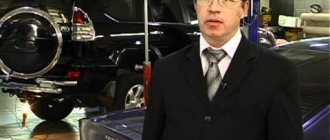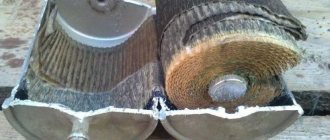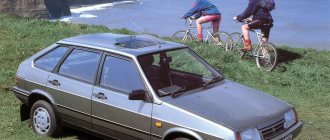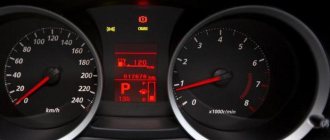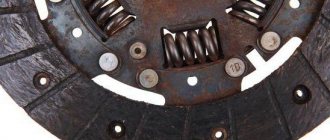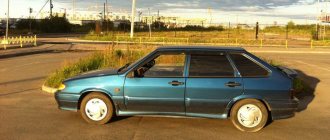The 2111 engine is conventionally considered “native” for the VAZ 2114, since it has been installed for 4 years since the creation of the car model. This version of the internal combustion engine has distributed injection and 4 valves and a volume of 1.5 liters. A tuned version of 21114 with a volume of 1.6 liters was also used by increasing the height of the cylinder block.
Drive VAZ 2114
In 2007, the engines were “pulled up” structurally to Euro-4 standards; the “four” was equipped with a 1.6 liter modification 11183 with 8 valves, an electronic gas pedal and an electric throttle, and a polymer receiver instead of aluminum.
Plastic receiver
Since 2009, the VAZ 2114 model has been modernized by its subsidiary Super-Avto CJSC. A 16-valve internal combustion engine 21124 with a volume of 1.6 liters and a power of 89 hp began to be used. With. A year later, the power unit was upgraded again; a modification of the 2126 engine of the same volume of 1.6 liters was used, but with a power of 98 hp. With.
ICE 21126
Characteristics of motors 2114
Since the release of the Lada Samara VAZ-2114, the technical characteristics of the gasoline drive have been constantly improved. Owners of domestic cars, in principle, do not have questions about what kind of oil to pour into the engine, since standard requirements apply for Zhiguli, Lada and Samara - 5W30 or 10W30.
Oil change 2114 with engine flush
In addition, you should know what kind of oil to use in transmission gears - the instructions from the AvtoVAZ manufacturer recommend using the GL-4 group of lubricants with a viscosity of 80W85 (mineral), 75W90T (synthetic) or 85W90 (semi-synthetic).
After filling with synthetics, the box becomes noisy, the oil is more expensive, but the lubricant is mostly imported, which provides additional guarantees. Domestic manufacturers most often produce semi-synthetics of average quality for engines and transmission gearboxes.
The technical characteristics of the engine are as follows:
| Characteristics | Engine modification | ||||||||
| 2111 | 21114 | 11183 | 21124 | 21126 | |||||
| Years of installation | 2003 – 2007 | 2003 – 2007 | 2007 – 2009 | 2009 – 2013 | 2009 – 2013 | ||||
| Volume | 1500 cm3 (1.5 l) | 1596 cm3 (1.6 l) | 1596 cm3 (1.6 l) | 1599 cm3 (1.6 l) | 1597 cm3 (1.6 l) | ||||
| Power | 56.4 kW (77 hp) | 59.5 kW (81.6 hp) | 59.5 kW (82 hp) | 65.5 kW (89.1 hp) | 72 kW (97.9 hp) | ||||
| Torque moment | 115.7 Nm (3200 rpm) | 125 Nm (3000 rpm) | 120 Nm (3200 rpm) | 131 Nm (3700 rpm) | 145 Nm (4000 rpm) | ||||
| Weight | 127.3 kg | 112 kg | 112 kg | 121 kg | 115 kg | ||||
| Compression ratio | 9,8 | 9,6 | 9,6 | 10,3 | 11 | ||||
| Nutrition | injector | ||||||||
| Engine diagram | Inline (L) | ||||||||
| Ignition | module | coil | coil | coil for each spark plug | |||||
| Number of cylinders | 4 | ||||||||
| Location of the first cylinder | TVE | ||||||||
| Number of valves on each cylinder | 2 | 2 | 2 | 4 | 4 | ||||
| Cylinder head material | aluminum alloy | ||||||||
| Intake manifold | aluminum | plastic with receiver | |||||||
| An exhaust manifold | with catalyst | ||||||||
| Camshaft | 2110 | 2111 | 2112 | ||||||
| Cylinder diameter | 82 mm | ||||||||
| Piston stroke | 71 mm | 75.6 mm | |||||||
| Pistons | Yes | No | No | Yes | No | ||||
| Valve bend | Yes | No | No | Yes | No | ||||
| Crankshaft | 2112 | 11183 | |||||||
| Fuel | AI-95 | ||||||||
| Environmental standards | Euro 4 | Euro 2 – 4 | Euro 3 – 4 | ||||||
| Fuel consumption highway/combined cycle/city | 5,7/7,3/10 | 6/7,3/10,4 | 6/7,8/11 | 5/7/9,5 | 5,4/7,2/9,8 | ||||
| Oil consumption per 1000 km | 0,7 | 0,5 | |||||||
| Engine oil for 2114 | 5W-30 and 10W-30 | ||||||||
| Engine oil volume | 4 l | 3.8 l | 3.5 l | 3.6 l | |||||
| Operating temperature | 95° | ||||||||
| Motor life | declared 150,000 km, real 250,000 km | ||||||||
| Adjustment of valves | washers between camshaft cams and tappets | hydraulic pushers | |||||||
| Cooling system | forced, antifreeze/antifreeze | ||||||||
| Coolant quantity | 7.8 l | ||||||||
| water pump | plastic impeller | ||||||||
| Candles for 2114 | A17DVRM, BPR6ES | AU17DVRM, BCPR6ES | |||||||
| Gap between spark plug electrodes | 1.1 mm | ||||||||
| Timing belt | length 698 – 1125 mm depending on attachments | ||||||||
| Cylinder operating order | 1-3-4-2 | ||||||||
| Air filter | Nitto, Knecht, Fram, WIX, Hengst | ||||||||
| Oil filter | Mann W914/2 | ||||||||
| Flywheel | 2110 | ||||||||
| Flywheel mounting bolts | M10x1.25 mm, length 26 mm | ||||||||
| Valve stem seals | code 90913-02090 inlet light code 90913-02088 exhaust dark | ||||||||
| Compression | from 14 bar | ||||||||
| XX speed | 750 – 800 | 800 – 850 | |||||||
| Tightening force of threaded connections | spark plug – 31 – 39 Nm flywheel – 61 – 87 Nm clutch bolt – 54 – 87 Nm bearing cap – 59 Nm (main) and 43 – 53 Nm (rod) cylinder head – four stages 20 Nm, 71 Nm + 90° + 90° | ||||||||
For high-quality maintenance of internal combustion engines, the engine manufacturer issues a manual containing a description of the drive parameters, the frequency of replacing consumables and step-by-step repair operations. The same operating manual recommends the volume of oil in the gearboxes in the engine.
Broken timing belt
What is the difference between the VAZ 2114 and the “nine”
The VAZ-2114 was created on the basis of the ninth model, but at the same time it has its own features that the ninth model does not have. This applies to both the appearance and technical characteristics of the machine.
The main task of the designers was to create a more modern and convenient car, which would at the same time retain all the positive aspects of the 2109 model, which became the “people's car”.
VAZ 2114 and VAZ 2109
The first thing that catches your eye when comparing two VAZ models is the smoother and “softer” contours of the VAZ-2114. Like the ninth model, the fourteenth is a five-door hatchback. But modification 2114 changed the outline of the hood, headlights, and added moldings. The front and rear bumpers have also changed.
Other differences between the VAZ-2114 and the “nine” include:
- New, more comfortable interior design with greater sound insulation.
- Front power windows, ashtrays for passengers were added, and the seats became more comfortable.
- The characteristic knocking sound that was in the cabin of the “nine” disappeared.
- The heating system was replaced with a more modern one, in comparison with the outdated system of the ninth model.
- The instrument panel has been replaced with a “European panel”, equipped with an on-board computer with sensors for temperature, network voltage, state of car systems, etc.
- There was a gradual modernization of the engine from 8-valve to 16-valve, with increased volume.
- Since 2011, a new electronic control unit has appeared on the car.
The 16-valve VAZ-2114 features an improved gearbox with “closed” bearings, which provide less loss of torque and reduced heating of transmission parts.
Differences between the VAZ 2114 and the VAZ 2109
The dimensions of the car have practically not changed - the VAZ 2114 is only 40 kg heavier and 10 cm longer than its predecessor. The suspension also remained the same, with minor modifications to the struts and shock absorbing system. According to reviews from car owners, the quality of the metal has improved - it is less susceptible to rust.
Engine design features
Initially, the engine of the VAZ-2114 was 8 valve, had a volume of 1.5 liters, complied with Euro-2 standards, and was marked 2111. In 2005, these engines were boosted:
- to increase the volume to 1.6 liters, the block is increased in height by 2.3 mm;
- Several configurations have been created - for Euro-2 version 21114-00, for Euro-3 model 21114-20 and for Euro-4 modification 21114-70;
- The crankshaft, valve system, camshaft correspond to 11183;
- The cylinder head received an enlarged combustion chamber of 5 x 8.1 cm, which increased power.
Combustion chamber of internal combustion engine 21114
An important feature of the 21114 internal combustion engine is phased rather than pairwise-parallel injection, which was used in the original 2111. The attachments have become more compact:
- catalytic collector instead of the neutralizer and exhaust pipe;
- injector ramp instead of the fuel return line.
Catcollector
The modernization also affected other components, for example, a January 7.2 or M7.9.7 controller was used, the ignition module was replaced with a coil with 4 terminals.
At the same time, VAZ-2114 began to be equipped with engines from Kalina 11183, which have some differences from the previous version:
- the shape of the combustion chamber has been improved;
- The generator is secured with a bracket, the tensioner is modernized.
In 2008, the 2114 engine received a new M73 ECU, and in 20011, the M74 “brains” to achieve Euro-4 standards. The control became completely electronic, but for another whole year the designers corrected firmware defects until they created its final version I414DE07.
ECU M74
The next engine, 2114, was installed on the car by a subsidiary of the manufacturer AvtoVAZ, called Super-Auto, in 2009. It was the 16 valve engine 21124 of the “tenth” VAZ family with improved characteristics:
- “high” blue block (197.1 mm);
- injectors pressed into 2–5 main bearing supports, cooling the pistons with oil;
- The groove depth of the holes in the valves is 5.53 mm, which ensures the safety of the valves in the event of a timing belt break; major repairs are not required.
Blue block
The following year, the fourteenth models began to be equipped with 21126 engines from export Priors. After tuning the 21124 engine, the internal combustion engine device differs in the following nuances:
- honed cylinders, gray block;
- crankshaft pulley and timing belt with semicircular tooth;
- the weight of the connecting rod and piston group is reduced;
- there is no friction in the lower head of the connecting rod;
- candle glasses are built into the head.
Piston group 21126
The internal combustion engine uses the principle of hydraulic compensation of valve clearances; the 0.45 mm thick cylinder head gasket is made of multilayer metal. The motor is equipped for Euro-3 with a collector 11194-1203008-10 or Euro-4 with a collector 11194-1203008-00. The service life of the pump has been increased due to a new design of the oil seal and bearing, and changes to the toothed pulley.
Hydraulic compensators
The ignition system has a separate coil for each spark plug. Phased injection, stainless steel fuel rail, January 7.2 or M7.9.7 controllers.
A little about the device and description
All engines were equipped with a 5-speed manual transmission. The gas distribution mechanism is belt driven. The first and second generations of vehicles (manufactured before 2007) were equipped with a simple on-board computer that did not regulate the operation of the engine from sensors.
Subsequently, it was decided to install ECUs that would completely regulate the performance of the motor using control sensors and regulate all ongoing processes.
Cons and pros
Depending on which 2114 engine is used, the owner’s risks differ:
- 2111, 21183, 21114 and 21124 – do not bend the valve if the timing belt breaks;
- 21126 – valve bending due to insufficient groove.
The main disadvantage of the latest 16 valve versions is the lighter crank mechanism:
- the engine is adjusted to Euro-4 standards;
- to reduce weight, the length of the piston skirt is reduced;
- Accordingly, the width of the oil scraper and compression rings decreases;
- The resource of the internal combustion engine is sharply reduced.
Grooves in the pistons so that the valves do not bend if the belt breaks
For example, in Japan, manufacturers abandoned Euro-4 standards, considering that the reliability and high service life of the motor are more important for the consumer.
The drive power increased from 77 horsepower to 81 hp, then 82 hp, 89 hp, and 98 hp. In models with hydraulic compensators, periodic adjustment of this unit is not required, however, the quality of the oil in the system must be high for normal operation of the pushers.
What is the salon equipped with?
The exterior of the VAZ is not for everyone. In order for the car to somehow correspond to the spirit of youth, the manufacturer gave the body sporty features: it rounded the hood, extended the headlights and moldings, and decorated the sill and bumper with body-color trims.
The interior is simple, but corresponds to the era of the early 2000s. The seats can hardly be called comfortable, so many people install an adapter or change the driver's seat. Although there is a Europanel, there is no glove compartment there. The only options available are power windows and an illuminated dashboard.
An unexpected bonus from AvtoVAZ is an adjustable steering column. It will allow you to raise and lower the steering wheel to the desired height to suit the height and build of the driver.
The trunk of the “fourteenth”, like the glove compartment of a jeep, is 330 liters. This will include a suitcase and a couple of bags from the supermarket. With the rear seats folded down, cargo space nearly doubles.
Maintenance schedule
To avoid having to carry out expensive overhauls of the Lada Samara 2114 yourself, you should follow the manufacturer’s recommendations for servicing the internal combustion engine:
| Maintenance object | Time or mileage (whichever comes first) |
| Timing belt | replacement after 100,000 km |
| Battery | 1 year/20000 |
| Valve clearance | 2 years/20000 |
| Crankcase ventilation | 2 years/20000 |
| Belts that drive attachments | 2 years/20000 |
| Fuel line and tank cap | 2 years/40000 |
| Motor oil | 1 year/10000 |
| Oil filter | 1 year/10000 |
| Air filter | 1 – 2 years/40000 |
| Fuel filter | 4 years/40000 |
| Heating/Cooling Fittings and Hoses | 2 years/40000 |
| Coolant | 2 years/40000 |
| Oxygen sensor | 100000 |
| Spark plug | 1 – 2 years/20000 |
| Exhaust manifold | 1 year |
If consumables are replaced within the recommended time frame, the operational life of the internal combustion engine will increase.
What kind of breakdowns will a novice driver encounter?
The driver who bought the “fourteenth” as his first car receives a real simulator for real driving. But the car is Russian, something will always break down in it. Here is what the former owner of the VAZ-2114, Igor Bolshakov from Yekaterinburg, said about the breakdowns:
“I drove a three-year-old “fourteenth” for several years. I bought it in 2010 with a mileage of 58 thousand km. This was my first car, so I didn’t choose alone, but with knowledgeable people. They pointed out to me the rust in the front wheel arches. Therefore, immediately after the purchase, according to the advice, I carried out anti-corrosion treatment, and also changed the oil and installed a spacer.
There were no engine knocks at idle, but the gearbox hummed and the lever vibrated. In winter, antifreeze was quickly used up. I was also surprised by the considerable gas consumption (a tank lasts 250-300 km). There were minor breakdowns: the generator belt broke, the lights needed to be replaced and minor electrical repairs were required.
However, there were also advantages: the car started well in cold weather, there were no complaints about the suspension or engine, the high seating position was pleasing, and, most importantly, the car drove. Overall, there were no big disappointments: I knew what I was buying. But we still had to invest in repairs and maintenance.”
If a novice driver does not have repair skills and money to visit auto repair shops, a broken car may be laid up.
Typical breakdowns
The very first 1.5 liter engine 2114 has disadvantages:
- periodic valve adjustment;
- unreliable injection system;
- loosening the exhaust manifold nuts;
- Leaking gaskets of the fuel pump, distribution sensor of the ignition system.
The next 1.6 liter engine does not cause any particular problems for the owner, with the exception of high vibration and noise loads. The weak point traditionally remains the valves, which have to be constantly adjusted.
Adjustment of valves
The internal combustion engine from Lada Kalina 11183 was installed on the fourteenth model solely to meet Euro-3 standards. It has typical disadvantages for a linear series and is no different.
The first sixteen-valve engine 21124 does not bend the valves, the gaps in which are adjusted by hydraulic pushers. However, the belt needs to be tightened after 15,000 km due to the large number of attachments. The second and last in the line of fourteenth ICE models, ICE 21126, has increased power. In addition to typical malfunctions, if the timing belt breaks, the piston will bend the valve due to insufficient recess depth.
TECHNICAL CHARACTERISTICS OF THE FOURTEENTH
First, let's look at the main characteristics of the VAZ 2114.
The fourteenth model is a 5-door hatchback, with the following body dimensions (mm): L – 4112, W – 1650, H – 1402. Vehicle weight – 970 kilograms, maximum loading weight – 470 kg.
The wheelbase of the VAZ 2114 is similar to the nine - 2460 mm, the track between the front wheels is 1400 mm, the rear - 1370 mm. In all modifications, the fourteenth has a front drive axle. Ground clearance between the body pan and the road is 170 mm.
The car is equipped with a 5-speed manual transmission with the following gear ratios:
- First speed – 3.636;
- Second – 1.95;
- Third – 1.357;
- Fourth – 0.941;
- Fifth – 0.784;
- Reverse – 3.53.
The fuel tank of the fourteenth holds 43 liters of gasoline. The fuel recommended by the manufacturer is AI95.
The VAZ 2114 has front disc brakes and drum brakes at the rear. The braking distance of a loaded car at a speed of 80 km/h is 38 meters.
The VAZ 2114 was produced with two engine options - 8 and 16 valves. All the differences between them are discussed in detail in the last section of the article.
Super car appearance
Despite the new model releases, there are few differences between them in terms of body appearance.
External changes: the front part of the body, the shape of the lenses, the hood, the radiator grille, better quality plastic on the bumper, spoilers, moldings and linings on the hood have changed.
After additional improvements in 2011, the super car received an increased ground clearance of 5 mm.
The weight of the vehicle is 970 kg, the load capacity is 425 kg and the ground clearance is 160 mm.
The VAZ 2114 vehicle has changed in many ways over time and differs from its predecessors in its new interior design and updated appearance.
It is equipped with external mirrors that have a rectangular shape, thanks to them the driver can better control the current situation on the road. The doors on super cars are equipped with special mechanisms for more convenient opening. It is equipped with wheels of 13 radius, which, if necessary, can be easily changed to a larger radius.
Modified headlights are built into the rear of the car; they have 3 types of brake lights, reverse and turn signals. The updated super car currently has a spoiler, it allows you to increase road grip and dynamic data of the car. This is a surprise for any car owner, since this element is installed immediately at the car factory before release.
Advantages and disadvantages of super cars
Each car, regardless of the manufacturer and type of model, has its own advantages and disadvantages, including the super car VAZ 2114.
Advantages: good aerodynamics, good appearance, playful power plants, good ground clearance, in demand by young people, great opportunities for tuning, initially the base car has a small and stylish rear stall, front-wheel drive, high stability, the bumper is painted completely to match the body color, enlarged wear resistance of the suspension, europanel on-board computer, heated front seats, front electric windows, low cost, cast wheels, adjustable steering wheel, easy repairs, low fuel consumption.
Cons: door handles often fail, the plastic bumper breaks easily, the car quickly rots, there is little free space inside the cabin, a weak level of security, the car does not have air conditioning or power steering, poor build quality, there is little space in the trunk.
Engine 21126 “Priora” (1.6 l., 16 cl.)
A continuation of the evolution of VAZ 16-valve engines was the engine with index 21126. It is a development of 21124, but with some changes. Among them:
- Lightweight ShPG (connecting rod and piston group);
- Better surface treatment;
- Honing of cylinders with more stringent requirements.
The timing drive is a belt drive with overhead camshafts. But unlike its predecessor, when it breaks, the valve bends. There is a radical solution to this design feature - replacing the pistons. If the engine is of a standard design, then you just need to carefully monitor the condition of the belt. Moreover, the problem with its weakening was solved by installing an automatic tensioner. The type of belt used was also changed.
Typical faults
If you feel a loss of power, then most often the reasons for this are the following phenomena:
- Loss of compression due to a burnt-out cylinder head gasket;
- Wear of the cylinder wall;
- Wear of piston rings;
- Piston burnout.
The result of unstable operation and refusal to start may be a problem with pressure in the fuel system. In addition, such symptoms are caused by sensor malfunctions, air leaks through leaky hoses or their connections, timing problems, or problems with the throttle valve.
If the engine is clearly “troubling”, then, first of all, it is necessary to check the compression readings to eliminate the problem of valve burnout. But more often this is caused by faulty spark plugs or a malfunctioning ignition coil. Sometimes the reason lies in the condition of the injectors, namely in the degree of their contamination.
Floating speed is a completely typical disease of VAZ 16-valve engines. Often, in addition to this, the engine runs unevenly. In this case, first of all, it is necessary to check the mass air flow sensor (MAF). If it is working properly, then most likely the cause is the throttle valve. It is necessary to clean it, and possibly replace its position sensor (TPS). At the same time, you should check the condition of the idle air control (IAC).
This engine was not without its signature headache with the thermostat. It also becomes the reason that the engine cannot warm up to operating temperature. However, if there is severe frost outside, perhaps the old-fashioned method of using cardboard in front of the radiator will help.
Some characteristic problems of other VAZ engines migrated to the 21126 Priora. So, if you detect knocking noises under the hood, you should first check the condition of the hydraulic compensators. Most often, they are the culprits of unpleasant knocking noises. At the same time, knocking noises that are associated with main and connecting rod bearings, as well as pistons, familiar from other VAZ engines, can also occur. This is already a serious malfunction, which is fraught with difficult engine repairs.
Minor problems, such as refusal to start, most often lie in the following malfunctions:
- Starter and battery;
- Ignition coil;
- Candles;
- Fuel pump malfunction;
- Clogged fuel filter;
- Faulty fuel pressure regulator.
Having improved its technical characteristics, the 21126 motor is still slightly inferior to its predecessor 21124 in reliability. Although it cannot be said that it is inferior very significantly. This is mainly due to the more complex design. Nevertheless, it is one of the best domestic engines, which also fits into modern environmental standards.
The declared resource is 200 thousand km. Compared to the officially declared resources of its predecessors, it has increased. However, in practice, older motors with a simpler design generally last longer. If we judge by reviews of actual use, then on average the actual resource corresponds to that specified by the manufacturer. Sometimes it can be more, sometimes less. Much depends on operating conditions and level of service.
What problems do “14s” have with mileage?
Young people, as a rule, get the most out of their cars, which is why there are a lot of damaged cars on the secondary market. Here is a live example, you don’t even need to look closely:
The avtocod.ru report shows that the car was involved in accidents three times:
In all three cases, the impact fell on the same part of the body:
The car was issued a copy of the title, there are restrictions on registration with the traffic police.
Another problem with used “fourteeners” is the twisted mileage. Here's a live example:
The mileage in the ad is 150 thousand km, in the report it is 146,343 km:
But in fact, the car has driven more than 200 thousand km:
This car is pretty tired and will probably require repairs. Better to look for something else.
Improving dynamic characteristics (tuning)
For many owners, the standard dynamics of the VAZ 2114 are not enough. Engine tuning allows you to improve the dynamics and customize the character of the car.
As practice has shown, chip tuning of VAZ 2114 engines does not lead to tangible improvements.
Let's look at more serious improvements:
- For owners of eight-valve engines, the easiest way to improve dynamics is to install a cylinder head from a 16-valve engine. Modification of the 1.5l block is also possible.
- The easiest way to tune a VAZ 2114 engine is to install camshafts different from stock. For example, OKB Dynamics 108 will give an increase in the highs without a noticeable loss in the lows.
- By supplementing the shaft with a sliding timing gear and a suitable phase setting, you can get + 7 hp. With.
- Installing an enlarged throttle valve (54 mm), a receiver and a 4.2.1 spider will improve cylinder purging and give noticeable changes during acceleration (the level is close to Priora).
- A modified cylinder head, lightweight valves and a modified intake manifold paired with an increase in engine volume to 1.6 liters will allow you to achieve a power of 110 hp. With. Tuning up to 120 horsepower will take place without loss of resource.
The principle of improving the power characteristics of sixteen-valve engines is similar to the process of refining V8 1.5i l and V8 1.6i l. More evil camshafts, direct-flow exhaust, a receiver, an enlarged damper, a lightweight Priorov piston group, in the case of the Kalina engine (124) and proper tuning will give a significant increase in dynamics.
Regardless of the number of valves per cylinder, the power of the VAZ 2114 engine can be significantly increased by installing a compressor or turbocharging. Engines modified in this way easily reach 170–190 hp. With.
There are many different configurations and options for improving the vehicle's dynamic performance. You can decide for yourself how to increase the power of the VAZ 2114 engine. Remember that the selection of mechanical modifications and software must match each other.


